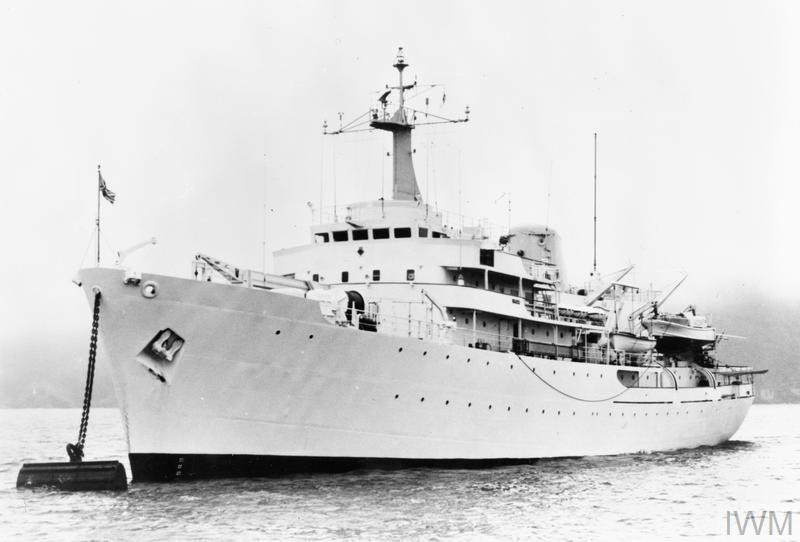Almost three weeks after the Argentine invasion of the Falklands and there were still ships leaving port for the long journey to the South Atlantic, adding more capabilities to the ever-growing Task Force sent to recapture the islands.
On Tuesday 20 April 1982 survey ship HMS Hecla left Gibraltar after another rapid conversion.
Hecla, her sister HMS Hydra and ‘improved’ sister HMS Herald had been chosen as ambulance ships, ready to work with hospital ship Uganda in a seamless process of moving casualties from battlefield to – ultimately – UK hospital.
The plan was that ambulance ships, with relatively shallow draughts, could run in close to the shores of the Falklands to pick up the wounded, and carry them out to Uganda in the designated Red Cross box.
Once stabilised, the trio of white-painted ships, bearing the distinctive red crosses, would transport patients on to Uruguay in South America, from where they could be flown back to the UK.
Like her sisters, who left Portsmouth at the end of the week, the 2,700-ton ship was fitted with emergency operating theatres in mess spaces, and some of her ship[‘s company were co-opted into the medical team – around 30 sailors were rapidly trained to help in the treatment of patients.
As it happened, the extreme sea states common in South Atlantic winters were deemed too much for the original plan, which would have seen Uganda operating many miles out to sea, and instead the converted liner moved closer inshore on a daily basis, allowing the three ambulance ships to concentrate on shuttle runs between the Falklands and Uruguay.
And the little ships clocked up some miles – by the time Hydra returned to home waters she had covered some 28,000 miles.
Hecla would be the first of the trio to run a casevac (casualty evacuation) trip to South America with 40 patients aboard, many of whom would no doubt have appreciated the good seakeeping qualities of the ships.
But that stability came at a price with Hecla managing to steam at a modest 14 knots at best, even with the slope in their favour, so having departed the Rock a day after Uganda she fell a further two days behind on the journey south.
Return trips between the Falklands and South America took around a week, and on the return leg the ambulance ships were able to deliver medical supplies, additional members of the medical team and fresh food.
The Great White Whale – P&O liner SS Canberra – and her accompany tanker British Esk, taken up by the MOD from the BP fleet, arrived off Ascension on 20 April, as did fast stores ship RFA Stromness, which dropped anchor off Clarence Bay, close to the main settlement of Georgetown on the west coast of the island.
Meanwhile, a noose was beginning to close – very slowly – on the Argentine invaders of South Georgia, which lies more than 800 miles to the east of the Falklands.
A small task group of ships – destroyer HMS Antrim, frigate HMS Plymouth, ice patrol ship HMS Endurance and tanker RFA Tidespring, later to be joined by frigate HMS Brilliant – had been making its way across the empty wastes of the South Atlantic, bringing with it six helicopters (Brilliant provided two more) and a force of around 250 men, including Royal Marines of M Coy 42 Cdo and special forces.
That force arrived off South Georgia overnight on 20-21 April, by which time nuclear submarine HMS Conqueror had already carried out reconnaissance work and patrols to look out for Argentine ships.
That reconnaissance work was complemented by a long-range radar reconnaissance mission flown by an RAF Victor aircraft from Ascension – a 7,000-mile, 14-hour round trip.
Further such flights followed on Thursday 22 April and Saturday 24 April.
* These posts can only give a brief sense of what was a complex and fast-moving situation 40 years ago, and cannot cover the involvement of every ship, squadron and unit in detail – for a much more comprehensive account see naval-history.net at https://www.naval-history.net/NAVAL1982FALKLANDS.htm
Today’s image from the Imperial War Museum collection (© IWM MH 27597) shows survey ship HMS Hecla before her conversion to ambulance ship for Operation Corporate. For more images from the Falklands Conflict, and other items from the extensive collection, see www.iwm.org.uk/collections
